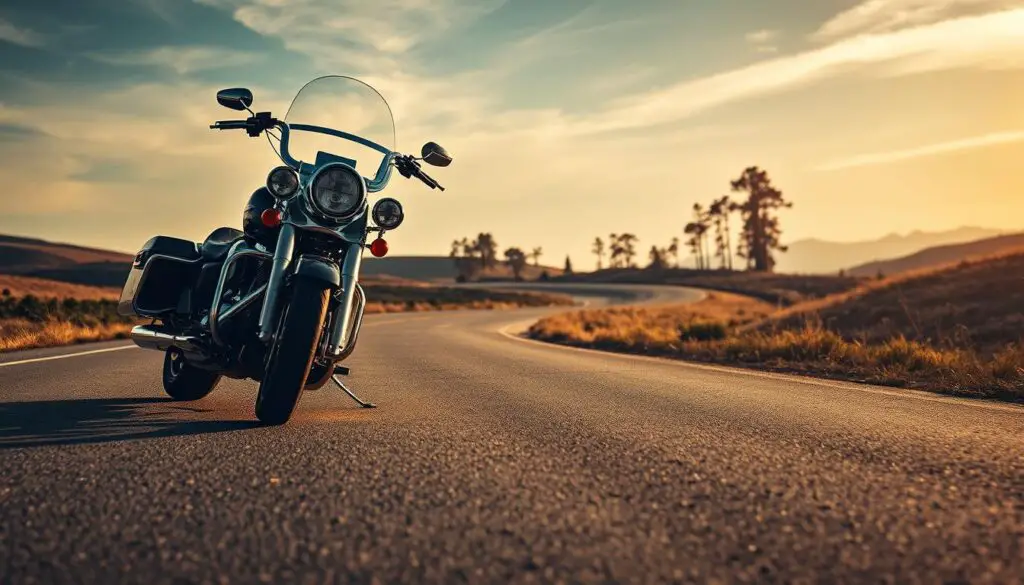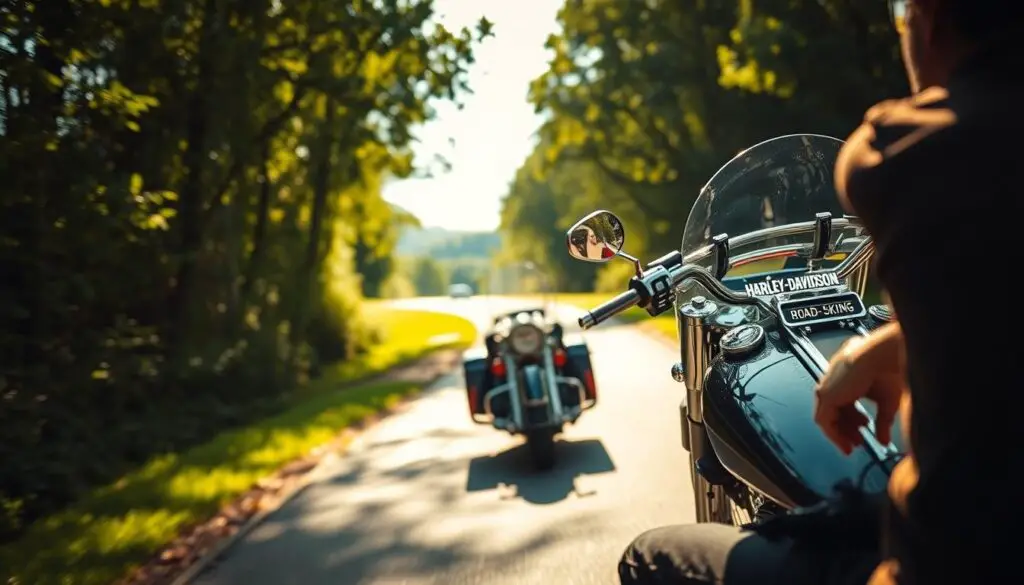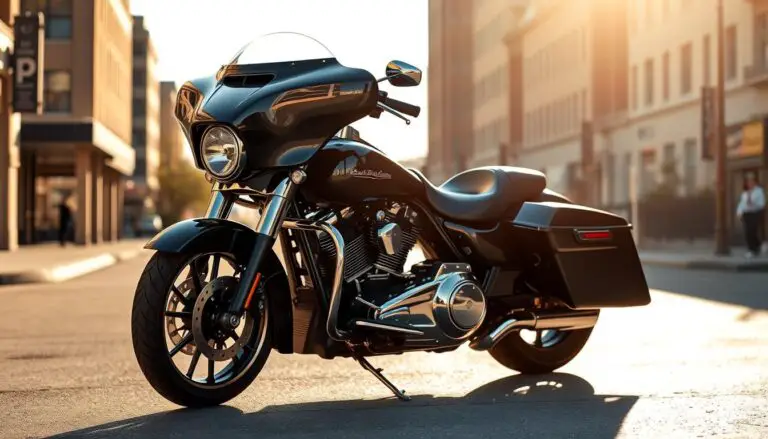Quick guide for buyers weighing used Harley-Davidson Road King models. This intro sets a clear, data-driven map of which production runs hold value and which bring service risks.
The Road King debuted in 1994, then moved through Evolution, Twin Cam, and Milwaukee-Eight engines. Well-kept examples from solid production runs keep resale strength; problem years often show up in owner reports.
Key chassis gains arrived in 2009–2013 with a robot-welded frame and a much stiffer swingarm. That era improved highway stability and cornering confidence.
The 2012 FLHR stands out: Twin Cam 103, six-speed Cruise-Drive, ABS, cruise control —a balanced touring spec for long miles. Early Twin Cam bikes (1999–2002) can suffer cam bearing and tensioner faults. Later trouble spots include 2003–04 oiling complaints, 2006 transmission feel, 2007–08 transitional issues, plus 2014–16 clutch and electrical recalls.
What this piece will do: name the model runs that deliver value, flag likely repair costs, and give a checklist to verify condition before you buy.
Key Takeaways
- 2009–2013 chassis upgrades made those models noticeably more stable.
- 2012 FLHR pairs useful touring features with a strong Twin Cam 103.
- Watch early Twin Cam cam bearings and cam chain tensioners (1999–2002).
- Check oiling, charging system, clutch history, and brake fluid routinely.
- Thorough maintenance can make a flagged model reliable and cost-effective.
Harley-Davidson Road King at a Glance: What Changed Over the Years
Significant mechanical revisions across production runs gave the Road King more torque, better handling, and improved long-distance manners. This short overview highlights the major engine eras, chassis overhaul, and touring-focused features that shape the riding experience.
From Evolution to Twin Cam to 103: Engine eras defined
The Evolution mills gave long service life and simple maintenance. In 1999 the Twin Cam 96 replaced the 88 with more than 700 revised components and a bump in torque to about 90.7 lb‑ft near 3,400 rpm.
By 2012 the FLHR shifted to the Twin Cam 103 (1,688–1,690 cc), raising torque to roughly 101.7 lb‑ft. That boost improved roll‑on acceleration for passing while loaded.
Touring DNA: chassis, suspension, electronics in context
In 2009 an all‑new robot‑welded frame used fewer parts and shorter welds. The result: a 20% stiffer frame, a 60% stiffer swingarm, and about a 67% increase in overall chassis stiffness. That change sharpened handling for sweepers without sacrificing highway composure.
Suspension stayed comfort‑biased before 2009; after the overhaul the bike tracked truer. Electronics such as ABS and cruise control arrived to ease long miles. Brakes use dual 292 mm front discs, and many owners fit braided lines and fresh fluid to match the bike’s weight.

- Models split between softer early setups and firmer 2009+ chassis tuning.
- Transmission feel improved with Cruise‑Drive six‑speed on later model runs.
- Rear air assist and largely nonadjustable forks set expectations for comfort versus fine tuning.
How We Evaluated the Best and Worst Road King Years
To judge each production run we layered rider reports, shop invoices, and documented production updates. This mix helped us separate isolated complaints from pattern problems.

Sources and inputs
Data came from: owner forums, publication road tests, recall records, and factory production notes. Each source earned weight based on sample size and repeatability.
Tested criteria
- Engine durability: cam bearing and tensioner design, signs of metal debris in the oil.
- Transmission behavior: shift quality, false neutrals, clunking.
- Fuel system and charging: pumps, lines, EFI pressure, stator history.
- Core chassis components: frame, swingarm, forks, and wear items.
Early twin cam engine runs showed plastic tensioner wear that can shed metal into the oil pump, then into the engine case. That cascade raises long‑term repair risk.
Maintenance history and documented 5K/10K services, plus a 50K big service, moved a model from risky to acceptable. We also penalized documented electrical or hydraulic clutch recalls when scoring value.
Best and Worst Road King Years
Certain production runs stand out for improved handling, fewer mechanical dramas, and higher resale value. This section names the model runs riders and data favor, then flags runs that need close inspection before purchase.
The “golden” runs called out by riders and data
The core golden run is 2009–2013. That block brought a 20% stiffer frame, a 60% stiffer swingarm, and about 67% more overall stiffness. Those gains improved high‑speed stability and cornering line holding.
2012 FLHR deserves special mention. It pairs the Twin Cam 103 with a six‑speed Cruise‑Drive, ABS, and cruise control for long miles. Well‑kept models from this run deliver balanced engine torque and usable touring features.
Years to approach with caution based on known issues
Early Twin Cam runs (1999–2002) show repeated cam bearing and plastic tensioner failures that can shed debris into the oil system. That contamination harms internal components unless addressed promptly.
Other flagged runs include 2003–2004 for fuel and oiling faults, 2006 for transmission feel and cylinder variability, 2007–2008 as transitional pre‑overhaul production, and 2014–2016 for hydraulic clutch recalls and electrical gremlins. Each of these model periods needs documented fixes and recall compliance to be attractive buys.
| Run | Key Strength | Main Concern | Buyer Action |
|---|---|---|---|
| 2009–2013 | Stiffer chassis; better handling | Few systemic faults | Verify service history |
| 2012 FLHR | Twin Cam 103, Cruise‑Drive, ABS | Wear items only | Check cruise, ABS function |
| 1999–2002 | Early value picks if upgraded | Cam bearing, chain tensioner debris | Inspect engine, oil for metal |
| 2014–2016 | Updated features on some models | Hydraulic clutch recall; electrical issues | Confirm recall fixes; test clutch |
Bottom line: model age tells part of the story. A well‑maintained caution‑year bike with documented upgrades can beat a neglected golden run. Always cross‑check recall compliance, inspect the engine and chain tensioner history, and test transmission feel before paying a premium for any Harley-Davidson road king.
The Best Years to Buy: Proven Road King Models for U.S. Riders
If you want a reliable touring machine, focus on the production runs that fixed chassis flex and added usable torque. These choices reward riders with steadier high‑speed handling and lower long‑term costs.
2009–2013: stiffer frame, improved ride
The 2009–2011 bikes gained a robot‑welded frame, 28‑spoke alloy wheels, and revised 2‑1‑2 exhaust. That 67% stiffness gain made a big difference in stability.
The Twin Cam 96 then led into the 103, which raised torque for relaxed roll‑ons. For touring use, this block pairs comfort with clear performance gains.
2012 standout
The 2012 FLHR combines the Twin Cam 103, Cruise‑Drive six‑speed, ABS, and cruise control. It is a balanced spec for long miles and daily touring chores.
1999 and 2005 classics
Vintage appeal is real for 1999 and 2005 models, but confirm cam chain tensioner and bearing upgrades on early twin cam bikes. Check service records closely.
2016 Road King/Classic
Late mid‑decade models add refined electronics, better comfort, and factory Classic trims—spoked wheels, leather bags, and extra chrome. For multi‑state trips, these are attractive if maintenance is current.
Road King Years to Avoid (And Why They Struggle)
Certain production runs carry a higher repair burden and deserve extra scrutiny before any purchase. If you target an older model, know the common fault patterns so you can price risk and plan inspections.
2000–2002: early twin cam pitfalls
The early twin cam engine used plastic cam chain tensioners and susceptible cam bearings. Failures can shed metal and plastic into the oiling circuit and oil pump. That contamination accelerates wear and risks major engine work unless the cam chest was upgraded.
2003–2004: fuel and oiling system patterns
These models often show inefficient oil pumps, gasket leaks when parked on the jiffy stand, and fuel delivery glitches that cause rough idle or stalling. Fragile plastics and rough shifting are commonly reported.
2006 and transitional builds
Owner reports list a clunky transmission feel, uneven cylinder performance, and stubborn hardware that complicates basic service. Test-ride linkage and shifts; difficulty selecting gears is a red flag.
2007–2008: skip or verify
These years precede the 2009 chassis overhaul. They inherit some Twin Cam quirks while lacking the later frame improvements, so many buyers prefer to wait for the post-2009 structure.
2014–2016: quality control and recalls
Documented hydraulic clutch recall reports non-disengagement linked to incidents. Owners also report saddlebag receptacle failures and intermittent electrical gremlins. Verify recall compliance, charging system health, and clutch function.
“Confirm cam chest upgrades, check oil for metal, and insist on a full test ride.”
| Years | Main Fault | Risk | Buyer Action |
|---|---|---|---|
| 2000–2002 | Cam bearings; chain tensioners | Engine contamination; major repair | Inspect oil, cam chest; request upgrades |
| 2003–2004 | Fuel delivery; oiling leaks | Stall; messy seals | Check pump flow; look for leaks |
| 2006 | Transmission feel; cylinder variance | Costly troubleshooting | Full test ride; compression check |
| 2014–2016 | Hydraulic clutch; electrical faults | Safety risk; intermittent faults | Confirm recalls; test clutch engagement |
Engine Evolution and Key Mechanical Milestones
A clear timeline of engine upgrades explains why some bikes deliver stronger torque and lower long‑term costs.
The Evolution mill offers simple service and modest output. It rewards routine oil care and basic checks.
Evolution versus Twin Cam 88/96/103
The Twin Cam 96 replaced the 88 by increasing stroke to about 1584cc and revising 700+ components. That change smoothed delivery and pushed gearbox/primary service intervals longer on select models.
The 2012 shift to the Twin Cam 103 (~1688–1690cc) raised torque to roughly 101.7 lb‑ft. The result was better performance for two‑up touring and heavy loads.
Cam chest changes, failure signs, upgrades
Early twin cam engines used plastic shoe tensioners that can shed material into the oil system. Metal particles score pumps and cam surfaces if the chain system fails.
- Signs of wear: abnormal chain noise, glitter in oil or filters, erratic oil pressure.
- Upgrades that matter: hydraulic tensioner kits, improved oil pump assemblies, and upgraded cam bearings.
| Area | Early Twin Cam | Later / Upgraded |
|---|---|---|
| Cam tensioner | Plastic shoe | Hydraulic conversion |
| Service cadence | Primary/gearbox 10K (earlier) | Extended intervals on TC96-era |
| Failure risk | Metal debris; scored pumps | Lower with bearings, pumps upgraded |
Practical note: a well‑documented cam chest service adds value. Prioritize bikes with receipts for these engine improvements over cosmetic work alone.
Ride and Performance Across Generations: What Buyers Will Feel
Riding different production runs reveals clear shifts in handling, braking feel, and long‑distance comfort.
Handling leap after chassis changes
Post‑2009 models use cast and forged joints, fewer parts, a frame about 20% stiffer and a swingarm near 60% stiffer. The immediate result is steadier tracking in sweepers and less mid‑corner wallow.
Braking, electronics, real stopping power
ABS is standard on many later model runs, improving confidence under panic stops. Expect a softer lever feel from stock lines; braided hoses and fresh fluid sharpen response.
Transmission, clutch, engine feel
Early gearboxes have an agricultural shift character. Cruise‑Drive six‑speed brings smoother changes and lighter cruise rpm for relaxed miles.
Hydraulic clutch action is lighter on some years but confirm recall compliance on certain 2014–2016 models before purchase.
| Feature | Early | Post‑2009 | Buyer Check |
|---|---|---|---|
| Handling | softer | stiffer, steadier | test at 70–80 mph |
| Brakes | spongier | ABS available | brake from speed; feel lever |
| Transmission | agricultural shifts | Cruise‑Drive smooth | shift through all gears |
| Engine | tractable torque | strong low‑end pull | check fuel response, midrange |
“Prioritize chassis condition — bearings, shocks, wheels — since a healthy frame makes the engine and transmission shine.”
Buyer’s Checklist for Used Road King Models
Use a short inspection routine before you close a deal. This helps you spot common faults that add repair costs.
Engine and oiling
Check for seepage at rocker boxes, primary cover, and transmission case. Review oil change cadence and inspect filter media for glitter — a clear sign of internal wear.
Confirm oil pump pressure feels steady. Noisy pumps or fluctuating pressure hint at cam chest wear or pump damage.
Cam chain tensioners and bearings
On early Twin Cam years request proof of hydraulic tensioner and bearing upgrades. Listen for chain rattle and ask to see service receipts for any replacement work.
Fuel system, electronics
Verify the fuel pump primes cleanly without a high-pitched whine. Test stator output; symptoms of failure include battery drain or starting trouble. Stator replacement is inexpensive compared with long-term charging issues.
Chassis, wheels, brakes
Inspect spoke wells for rust and chrome pitting. Confirm shock action; over-pressurization can leave zero damping. Check ABS function where equipped and review brake fluid service—flush every two years.
Service history and test ride
Prefer full 5K/10K records and a 50K big service with belt replacement noted. On a test ride evaluate shifts for missed gears, false neutrals, or slippage. Insist on receipts over verbal claims.
| Area | What to look for | Buyer action |
|---|---|---|
| Engine & oil | Seepage; glitter in filter | Demand oil history; lab filter check |
| Cam chest | Chain noise; missing upgrades | Request documented hydraulic conversion |
| Fuel/charging | Pump whine; battery drain | Test pump, stator output; plan replacement |
| Chassis & wheels | Rust in spoke wells; soft shocks | Inspect chrome; check frame alignment |
| Service | Missing 5K/10K receipts; no 50K service | Prefer bikes with full records; negotiate if absent |
Total Ownership View: Costs, Reliability Mods, and Parts Availability
Owning a road king is more than purchase price. Expect routine service at 5K and 10K intervals, with a 50K big service that covers head bearings, forks, and belt replacement near 50K miles.
Upgrades that pay off
Prioritize hydraulic cam chain tensioners and higher-flow oil pumps on twin cam machines. These stabilize the oiling system and cut long-term engine repair risk.
Fit braided brake lines with fresh fluid for firmer braking on heavy touring loads. Test charging output and replace a weak stator or regulator-rectifier early to avoid battery drain or hard starts.
Parts ecosystem
The Classic variant has broad accessory support. OEM and aftermarket parts are plentiful across U.S. suppliers for screens, bags, chrome trim, and common replacement components.
- Transmission feel: inspect shift linkage; adjustment often cures notchy action on earlier models.
- Watch for signs of deferred care—dark brake fluid, loose steering, worn shocks—these predict extra spend.
- Keep records: documented mods and services raise resale and simplify future maintenance.
“A slightly higher price for a well-updated bike usually beats a cheap, unmodified example that needs cam chest or brake work.”
| Item | Why | Action |
|---|---|---|
| Hydraulic tensioner | Reduces chain wear | Install on early twin cam |
| Brake lines & fluid | Improves stopping | Replace; flush every two years |
| Stator/regulator | Prevents drain | Test; replace if weak |
Comparable Touring Alternatives Worth Considering
If you want a touring bike with richer factory electronics, several non‑Harley models deserve a close look. These alternatives trade different strengths: more systems, lighter weight, or higher output while keeping big‑twin character for long miles.
Indian Springfield: heritage vibe with more electronics
The Springfield uses an 1811cc V‑twin and bundles ABS, cruise, TPMS, adjustable pillion boards, plus centrally locked panniers. For riders who value kit over tinkering, this model often needs less aftermarket work to be tour‑ready.
Used 2016 examples trade roughly £7,800–£8,500, offering strong spec for the money.
Kawasaki Vulcan 1600: value, lighter weight, better gearbox feel
The Vulcan delivers about 65.7 bhp with 93.7 lb‑ft torque at a curb near 307 kg. It costs less used—around £4,400–£5,400—and the transmission wins praise for smooth shifts versus many big American boxes.
If you ride city streets or prefer easier low‑speed handling, the lighter chassis can be a real advantage.
Triumph Thunderbird 1700 LT: performance tilt with cruiser character
The Thunderbird’s roughly 92 bhp and 111.4 lb‑ft pair with a dry weight near 349 kg. It leans toward stronger performance while keeping cruiser ergonomics for long days in the saddle.
Expect used values near £6,500–£8,200 depending on spec and condition.
Quick comparison notes:
- Indian Springfield adds the richest factory system set among these rivals.
- Kawasaki gives lower purchase cost plus a friendlier gearbox for daily use.
- Triumph emphasizes higher output for riders seeking more performance on long runs.
- Parts availability and service reach vary; Harley’s network is widest in the U.S., while Indian and Triumph support can be regional.
- Match the platform to your use: heavy interstate touring, mixed commuting, or weekend riding each favor a different choice.
| Model | Key spec | Typical used price (2016) |
|---|---|---|
| Indian Springfield | 1811cc; ABS, TPMS, locking panniers | £7,800–£8,500 |
| Kawasaki Vulcan 1600 | 65.7 bhp; 93.7 lb‑ft; 307 kg | £4,400–£5,400 |
| Triumph Thunderbird 1700 LT | ~92 bhp; 111.4 lb‑ft; ~349 kg | £6,500–£8,200 |
Final tip: compare maintenance history, current upgrades, and comfort fit before choosing. A well‑serviced alternative can out‑value a similar priced road king classic that needs parts or system work.
Conclusion
A practical buying lens shows which production runs deliver steady performance with fewer surprise repairs.
Short answer: favor the 2009–2013 road king block, with the 2012 FLHR and its Twin Cam 103 often the most balanced for touring use.
Demand proof of cam chest upgrades on early twin cam engine models; cam chest debris is a known cause of long‑term engine harm. Verify 2014–2016 recall fixes for clutch and electrical faults before you buy.
Test transmission feel, fuel delivery, oil pressure, and charging output on a full ride. Prioritize documented 5K/10K service and a 50K big service over cosmetics.
Good prep saves time and money. Pick the right model for your miles, favor reliability upgrades, and buy the best‑maintained Harley-Davidson road king you can find.
